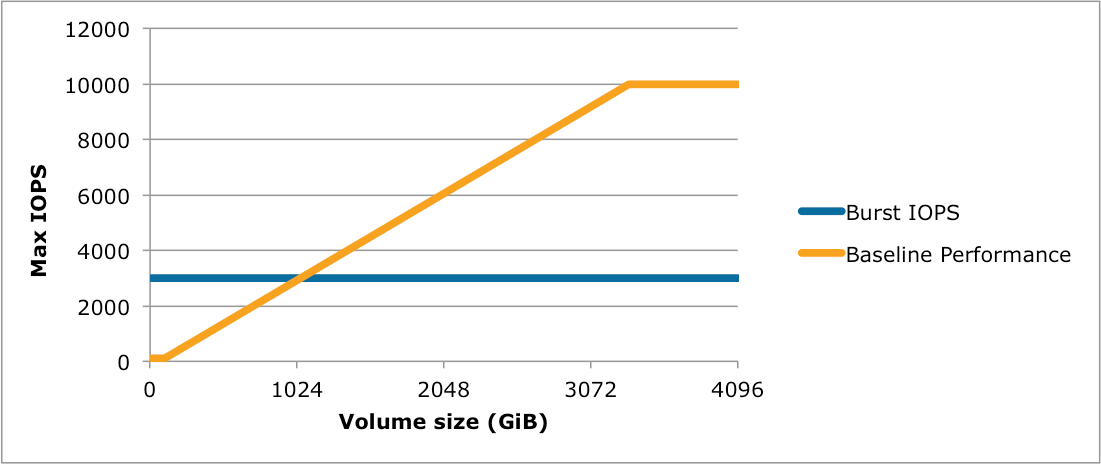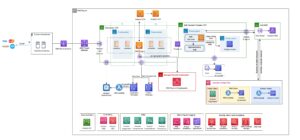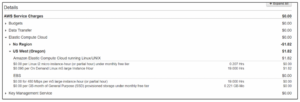AWS Burst Credits are a feature that allows Amazon Web Services (AWS) instances to burst beyond their baseline performance for a limited period. Burst Credits are accumulated when the instance operates below its baseline, and they are consumed when the instance requires more performance than its baseline allows.
Burst Credits can be a cost-effective way to handle short-term spikes in workload without having to constantly provision resources for peak demands. AWS Burst Credits are a valuable feature provided by Amazon Web Services (AWS) that enables instances to temporarily exceed their baseline performance.
This allows businesses to handle sudden surges in workload without incurring excessive costs. By accumulating credits during periods of low usage, organizations can tap into these reserves when they experience high-demand situations. Burst Credits are a flexible solution that strikes a balance between cost efficiency and performance optimization. In this blog post, we will explore the concept of AWS Burst Credits in more detail, discussing how they work, their benefits, and considerations for effective utilization. So, let’s dive in and discover the power of Burst Credits in AWS.
Introduction To Aws Burst Credits
The Concept Of Bursting In Cloud Computing
Cloud bursting dynamically scales resources beyond the initial capacity.
Aws’s Approach To Scalable Performance
AWS Burst Credits enable burstable performance for EC2 instances.

Credit: docs.aws.amazon.com
Demystifying Burst Credits
Unraveling the mystery of AWS burst credits sheds light on their role in managing instance performance. Burst credits allow instances to burst above baseline performance for temporary periods, crucial for maintaining operational efficiency in AWS environments. Understanding burst credits is key to optimizing AWS resource utilization.
How Burst Credits Work
Burst Credits is a feature in Amazon Web Services that allows users to increase their CPU usage beyond the baseline limit for a limited time. This feature is available in instances that use the T2 and T3 instance types. AWS provides each instance with a certain amount of burst credits that can be used to increase the CPU usage. Once the credits are exhausted, the CPU usage returns to the baseline limit.The Role Of Credits In Aws Services
In AWS, Burst Credits are used to allow users to handle short-term spikes in CPU usage without having to upgrade their instance. This feature can be used by applications that require occasional high CPU usage, such as web servers, development environments, and small databases. Burst Credits can also be used to handle unpredictable workloads, such as those generated by user activity on a website. Burst Credits are a powerful tool for AWS users to handle short-term spikes in CPU usage without having to upgrade their instance. By understanding how Burst Credits work and their role in AWS services, users can make informed decisions on how to best manage their application’s workload. With the right usage of Burst Credits, users can optimize their costs and ensure their application’s performance and availability.Eligible Aws Services For Burst Credits
The AWS burst credit model allows certain services to operate beyond their baseline performance level for a limited time by accumulating credits when they’re not using the full capacity of the resource. This enables bursts of high performance when required. Let’s explore the AWS services that are eligible for burst credits.
Ec2 Instances And Burst Credits
EC2 instances are eligible for burst credits, which enable them to temporarily operate at higher performance levels. This is particularly beneficial for workloads that experience occasional spikes in usage, allowing them to leverage burst credits to handle increased traffic or processing demands.
Ebs Volumes: Enhanced Performance
When attached to burstable EC2 instances, EBS volumes can enhance performance through burst credits. This allows EBS volumes to accommodate sudden spikes in I/O activity, delivering higher performance levels when needed without compromising on cost-effectiveness.

Credit: aws.amazon.com
Monitoring And Managing Burst Credits
When working with Amazon Web Services (AWS), it is essential to understand the concept of burst credits. These credits are used by AWS EC2 instances to burst above their baseline performance when needed. However, if you exceed your allotted credits, you may experience performance issues. Therefore, it is crucial to monitor and manage your burst credits to ensure optimal performance and avoid unexpected costs.
Tools For Tracking Credit Usage
Fortunately, AWS offers several tools to monitor and track your burst credit usage. The first tool is Amazon CloudWatch, which allows you to monitor your EC2 instances’ burst credit balance and usage. This tool provides insights into your credit balance over time, so you can plan your workloads accordingly.
Another tool available is AWS Trusted Advisor, which provides recommendations to optimize your EC2 instances’ performance and cost. It helps you identify instances that are consistently running low on burst credits and suggests ways to optimize your usage.
Best Practices For Burst Credit Management
To effectively manage your burst credits, there are several best practices to follow. Firstly, it is essential to monitor your credit usage regularly to ensure you do not exceed your credits’ allotted amount. Secondly, it is advisable to reserve instances, which guarantees a certain amount of burst credits for your instance to use.
Another best practice is to use auto-scaling groups, which automatically adjust the number of instances running based on demand. This helps ensure that your instances have enough burst credits to perform optimally without exceeding your credit balance.
Finally, it is crucial to properly size your instances to ensure they have enough baseline performance to handle your workloads without relying heavily on burst credits.
In conclusion, monitoring and managing your AWS burst credits is essential to ensure optimal performance and avoid unexpected costs. By utilizing the available tracking tools and following best practices, you can effectively manage your burst credits and optimize your EC2 instances’ performance.
Maximizing Performance With Burst Credits
Burst credits in AWS provide the ability to burst CPU usage for T2 and T3 instances. When workloads need to exceed the baseline performance, burst credits enable temporary spikes in CPU usage without impacting overall performance. This feature optimizes performance and ensures efficient resource utilization.
Strategies For Efficient Use
When it comes to maximizing performance with AWS Burst Credits, there are several strategies you can employ to ensure efficient use. By implementing these strategies, you can make the most out of your burstable instances and optimize your AWS resources.
- Monitoring Burst Credit Balance: It is crucial to regularly monitor the burst credit balance of your instances. By keeping an eye on this metric, you can determine when your instances are approaching their credit limit and take necessary actions to prevent performance degradation.
- Utilizing Burst Credits Wisely: To maximize the performance of your burstable instances, it’s important to use your burst credits wisely. This means optimizing your workloads and minimizing unnecessary resource consumption during burstable periods.
- Implementing Autoscaling: Autoscaling is a powerful tool that can help you effectively manage burst credits. By automatically adjusting the number of instances based on workload demands, you can ensure efficient use of burst credits and maintain optimal performance levels.
- Choosing the Right Instance Type: Selecting the appropriate instance type for your workload is essential for efficient use of burst credits. Understanding the burstable performance characteristics of different instance types can help you make informed decisions and avoid underutilization or overutilization of resources.
Aligning Workloads With Burst Capabilities
Aligning your workloads with the burst capabilities of your instances is another crucial aspect of maximizing performance with AWS Burst Credits. By understanding the burstable performance profiles of your instances and optimizing your workloads accordingly, you can ensure efficient resource utilization and avoid performance bottlenecks.
- Identifying Burstable Periods: Analyzing your workload patterns can help you identify burstable periods when your instances accumulate burst credits. By scheduling resource-intensive tasks during these periods, you can take advantage of the burstable performance and maximize the efficiency of your instances.
- Optimizing Burstable Workloads: To fully leverage burst credits, it’s important to optimize your burstable workloads. This involves prioritizing critical tasks, optimizing resource allocation, and minimizing unnecessary resource consumption during burstable periods.
- Burst Credit Planning: Planning your burst credit usage in advance can help you align your workloads effectively. By estimating the burst credit consumption of different tasks and allocating resources accordingly, you can ensure a smooth and uninterrupted performance during burstable periods.

Credit: docs.aws.amazon.com
Cost Implications Of Burst Credits
The cost implications of burst credits in AWS are a critical consideration for businesses seeking to optimize their cloud resources. Understanding the billing for burst credits and optimizing costs while bursting can significantly impact the overall expenditure. Let’s delve into the details of how burst credits affect the cost structure and how businesses can make the most of this feature.
Understanding Billing For Burst Credits
When utilizing burstable instances in AWS, it’s essential to comprehend the billing mechanism associated with burst credits. These credits are designed to allow instances to temporarily burst above the baseline performance level. Unused burst credits can be accumulated for future use, providing cost-effective flexibility for fluctuating workloads. However, it’s crucial to monitor and manage burst credit utilization to avoid unnecessary expenses.
Optimizing Costs While Bursting
To optimize costs while utilizing burst credits, businesses should consider implementing efficient resource utilization strategies. This includes right-sizing instances to match workload requirements, leveraging auto-scaling to dynamically adjust capacity, and utilizing monitoring tools to effectively manage burst credit utilization. By implementing these strategies, businesses can ensure optimal performance while minimizing unnecessary costs associated with burst credits.
Common Scenarios And Use Cases
Aws Burst Credits are a valuable resource for managing workloads on AWS EC2 instances. Burst Credits allow instances to burst beyond their baseline performance, ensuring smooth operations during peak periods. By accumulating credits during idle periods, instances can utilize them for bursts of high CPU usage when needed.
Handling Sporadic Traffic Spikes
AWS Burst Credits are crucial for managing sudden increases in website traffic.
Case Studies: Success Stories Of Bursting
Real-life examples demonstrate the effectiveness of utilizing AWS Burst Credits.
Troubleshooting And Faqs
Aws Burst Credits are a type of virtual currency used in Amazon Web Services to help manage unexpected spikes in usage. These credits are automatically earned over time and can be used to cover additional usage fees beyond the normal limits of your AWS plan.
Troubleshooting and FAQs related to Burst Credits can be found on the AWS website.
Common Issues And Solutions
Having issues with AWS Burst Credits? Here are common problems and their solutions:
- Problem: Running out of burst credits quickly.
- Solution: Optimize instance usage and upgrade to a larger instance if needed.
- Problem: Inconsistent burst performance.
- Solution: Monitor instance metrics and adjust workload for better performance.
Expert Answers To Frequently Asked Questions
Get expert answers to your burning questions about AWS Burst Credits:
- Q: How do burst credits work?
- A: Burst credits allow instances to temporarily burst above baseline performance.
- Q: Can burst credits be accumulated?
- A: No, burst credits cannot be accumulated or carried over.
Looking Ahead: The Future Of Burst Credits
Frequently Asked Questions
What Does Burst Mean In Aws?
In AWS, burst refers to the ability of an instance to temporarily use more CPU credits than its baseline. This allows for increased performance when needed.
What Is Burstable And Non-burstable?
Burstable and non-burstable are two types of cloud computing instances. Non-burstable instances provide consistent performance, while burstable instances allow for temporary increased performance when needed. Burstable instances have a baseline performance level and can burst above that level for a limited time before returning to the baseline.
What Happens When Cpu Credits Run Out?
When CPU credits run out, performance may be limited until more credits are earned or purchased.
What Is Burstable Compute?
Burstable compute is a feature that allows for increased CPU performance when needed. It provides flexibility by allowing you to use additional compute resources temporarily, beyond the normal limits of your allocated resources. Burstable compute helps handle sudden spikes in workload without compromising performance.
Conclusion
Understanding AWS burst credits is vital for optimizing cloud workloads. By grasping the concept of burstable performance instances and managing burst credits effectively, businesses can enhance cost-efficiency and performance. Leveraging burst credits intelligently can help maintain consistent performance levels while managing costs within the AWS environment.






